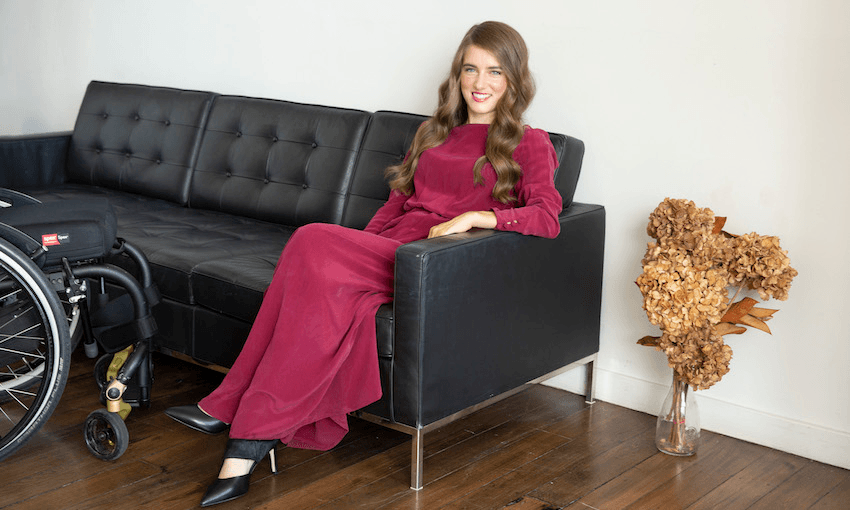Alex Casey talks to Grace Stratton, founder of All is For All, about creating a pioneering online store that makes accessibility a priority.
It all began last July with an uninvited tie. Grace Stratton – fashion enthusiast, uni student and wheelchair user – had bought a pair of pants online from a New Zealand designer, and was eagerly awaiting their arrival on her doorstep. She unwrapped them to find an extra tie on the garment that hadn’t been visible on the website. “I was pretty bummed out because now, if I wanted to wear them, I would need a parent or caregiver to help me. It just felt like a part of my independence has been taken away from me.”
Stratton may have lost a lovely pair of pants from the debacle – but she gained a bloody good idea. “I thought to myself, ‘Why is this a thing that keeps happening? Why isn’t there more information for people like me online?’ The more I thought about it, the more I realised it can’t just be my experience – this must have happened to other people.”
Creating a Google survey and circulating it among her friends with accessibility needs, she soon realised the pitfalls of online shopping were an ongoing problem for many.
There are several different things that people with access needs have to consider when they are shopping online, says Stratton. “For example, if I’m looking to buy a dress and I look at that dress on a model who is standing up, I could go to put it on and it will look totally different on me because I’m wearing it sitting down.” A pair of jeans with small metal rivets can cause sores for a person who is paraplegic. An imperceptible hook and eye can be the difference between someone being able to dress themselves or not.
Beyond the details of the garments themselves, the layout of an online shopping store can also limit who can access it. “For a blind person shopping online, their experience is vastly guess work,” says Stratton. Those who aren’t able to see product overviews or images are reliant on audio descriptions, which is reliant on resource. “The only way that function can actually work is if someone sits there and writes the description of the photo,” says Stratton. “The fashion industry is already stretched so thin, nobody has time to spend 20 minutes writing about one photo.”
Nobody, that is, except her.
Stratton’s new website All is For All looks to solve many of the limitations that come with online shopping. Working with fashion insider Angela Bevan to get brands like Penny Sage, Ingrid Starnes and Ruby on board, Stratton casually drops that the site is probably a world first. “We spend time doing in-depth object descriptions of the garments, we take more photos than an average website would do, we shoot in high contrast with a lot of light and our whole website is black and white with no colour.”
Part of the ethos of All is For All is to remove the idea of separation between disability and the mainstream. “In fashion, designers will build a separate collection for people with accessibility needs,” says Stratton, citing the recent Tommy Hilfiger adaptive collection. “It doesn’t really help anyone because it still keeps the person who has a ‘difference’ away from the mainstream market,” she says. “In New Zealand specifically there’s not a lot of money, so of course we can’t expect people to rejig their entire collection for us.”
What designers can afford to do, however, is hand their garments over to All is For All, who can provide a more in-depth product and accessibility description and represent their clothes in a whole new light to a whole new audience. “We upload all the details that people with access needs need to know. We’ll make the photos accessible – they basically don’t have to do anything and they’ll open up their clothing to a new market… I basically see us as filling in some of the gaps that current online shopping is missing.”
Another element to the business is the All agency, which Stratton hopes will help boost diversity in the New Zealand modelling industry. “We had to find all of the models for the site ourselves,” she says, admitting to stalking many of them on Instagram and Facebook prior to casting them. “Since we found them, we thought we might as well represent them too.” By using only models who have disabilities, she hopes to remedy the lack of representation in the fashion magazines she read growing up.
“It’s starting to get better now, but diversity still has so much more to offer,” says Stratton. “There are so many people with disabilities who don’t get the spotlight because they aren’t cool enough or they don’t look a certain way. We want to put all kinds of people on our website because the majority of messaging out there about disability is still really negative. I just want to show everyone that we’re a pretty cool group of people.”
“I’ve been looking at models who are standing up my whole life,” she adds. “Time to look at a model in a wheelchair for a while, you know?”



